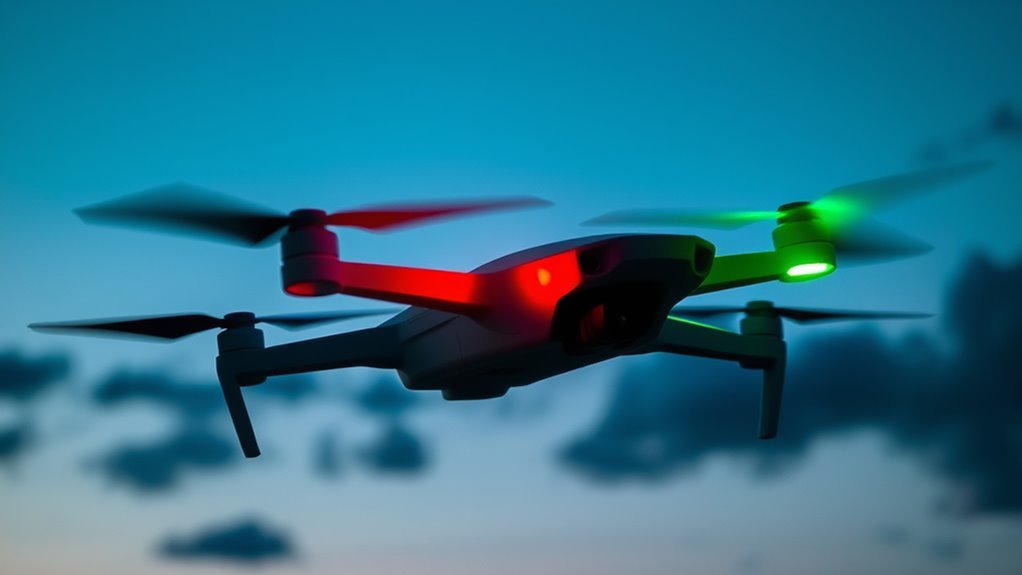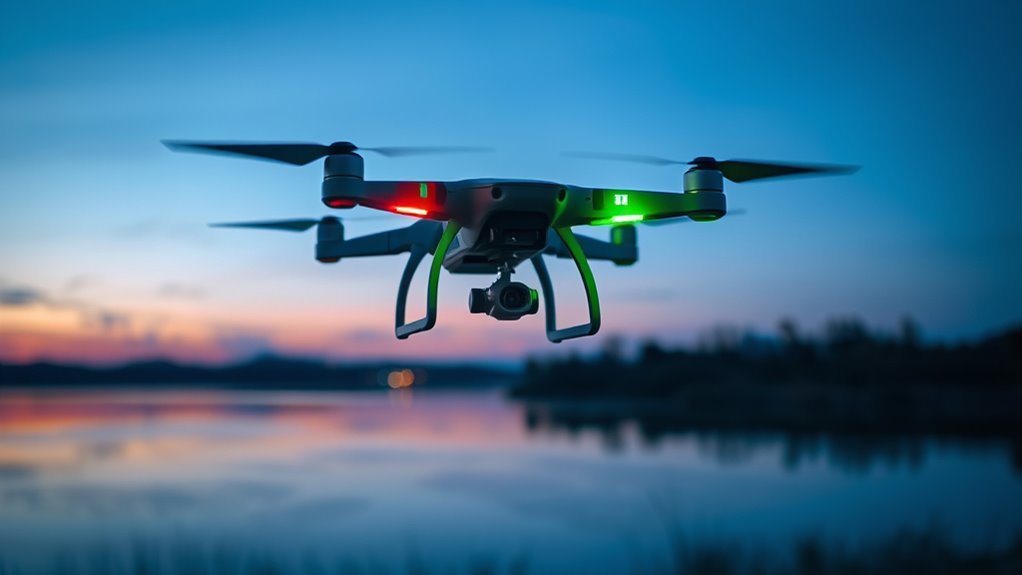Drones use red and green lights to indicate their orientation and direction. The red light signifies the left side, while the green light represents the right side, which enhances visibility and helps minimize collision risks in crowded airspace. Additionally, these color codes support compliance with nighttime regulations, where specific light configurations are required for safe operation. Understanding these indicators is essential for effective navigation and situational awareness during flights, offering insights into various drone operations.
Overview of Drone Lighting Systems

Drone lighting systems play an essential role in aerial navigation and safety. These systems enhance drone visibility, ensuring pilots and observers can easily identify the aircraft’s position and orientation. Recent lighting advancements have led to more efficient LED technology, allowing for brighter and more energy-efficient lights. This improvement not only increases visibility but also extends flight time, enhancing operational freedom. Various lighting configurations, including strobe and navigation lights, help in communicating the drone’s status, especially in low-light conditions. As a pilot, understanding these systems is vital for safe maneuvers and compliance with regulations. By leveraging advancements in drone lighting, you can greatly improve situational awareness and operational efficiency, fostering a safer environment for all aerial activities.
Purpose of Red and Green Lights

The use of red and green lights in aviation, including drone operations, serves a critical function in ensuring safe navigation and orientation. The red light significance lies in its role as a visual indicator of the drone’s left side, helping you identify its direction and position relative to other air traffic. Conversely, the green light meaning denotes the right side of the drone, providing essential information for maintaining separation in crowded airspace. This color coding not only enhances situational awareness but also promotes safety by minimizing the risk of collisions. When flying your drone, understanding these lights enables you to make informed decisions, allowing for greater freedom in your aerial pursuits while adhering to essential safety protocols.
Understanding the Color Coding

Understanding the color coding of drone lights is essential for compliance with night flight regulations and safe navigation. Red and green indicators serve vital functions in enhancing situational awareness and preventing collisions. By grasping these standards, you’ll improve both your operational efficiency and safety in the air.
Night Flight Regulations
While flying at night, it’s important to recognize the specific color coding of navigation lights on unmanned aerial vehicles. Understanding these lights not only enhances nighttime visibility but also guarantees regulatory compliance, allowing you to operate freely within the rules.
- Red lights indicate the left side of the drone.
- Green lights signify the right side.
- White lights are typically used for rear visibility.
Adhering to these color codes is vital for safe operations, especially in shared airspace. By recognizing and understanding these lights, you can avoid potential collisions and make certain your drone is easily identifiable to others. Staying informed about night flight regulations empowers you to fly confidently while respecting safety protocols.
Navigation Indicators
Recognizing the color coding of navigation lights is essential for effective drone operation, particularly in low-visibility conditions. Understanding these indicators can enhance your drone visibility and guarantee you’re adhering to navigation technology standards.
| Light Color | Meaning | Importance |
|---|---|---|
| Red | Indicates the left side of the drone | Helps maintain proper orientation |
| Green | Indicates the right side of the drone | Assists in identifying direction of travel |
| White | Often used for rear or belly lights | Enhances visibility for other operators |
Safety and Awareness
The color coding of drone lights plays a significant role in ensuring safety and awareness during flight operations. By understanding these indicators, you enhance your drone safety and implement effective awareness strategies. Here’s what you need to know:
- Red Lights: Indicate the drone’s rear and signal potential hazards.
- Green Lights: Show the front orientation, essential for directional awareness.
- Flashing Lights: Often denote active flight modes or emergency signals.
Recognizing these signals fosters a safer flying environment, enabling you to anticipate actions and avoid collisions. When you’re aware of your drone’s light signals, you not only comply with regulations but also elevate your responsibility as an operator. Understanding color coding is essential for maintaining freedom in the skies while ensuring the safety of all.
Orientation and Navigation
In drone operations, the color of lights plays an essential role in orientation and navigation. Red and green lights indicate the drone’s direction and help you assess its flight pattern, which is vital for maintaining situational awareness. Understanding these signals not only enhances safety but also improves your ability to control the aircraft effectively.
Light Color Significance
While maneuvering in various environments, understanding the significance of drone light colors—specifically red and green—plays an essential role in orientation and effective navigation. These colors not only enhance drone visibility but also leverage light color psychology to convey vital information.
- Red lights typically indicate the drone’s rear, essential for maintaining spatial awareness.
- Green lights are often positioned at the front, assisting in directionality during flight.
- Flashing patterns can signal operational status or alerts, enhancing communication with other pilots.
Flight Pattern Indicators
Understanding flight pattern indicators is essential for effective drone navigation. These indicators, often represented by light visibility, help you determine the orientation and movement of your drone in real-time. The red and green lights signify different flight patterns; green typically indicates forward motion, while red suggests backward or stationary status. By interpreting these lights, you can assess your drone’s position and trajectory, ensuring it maintains a safe and efficient path. Additionally, being aware of these indicators enhances your situational awareness, allowing you to adjust your flight patterns as necessary. Mastering this aspect of drone operation not only empowers your navigational skills but also contributes to the overall safety and freedom of your flying experience.
Regulatory Standards for Drone Lights
Regulatory standards for drone lights are essential for ensuring safe operations in both commercial and recreational airspace. These standards help maintain visibility and prevent collisions, enhancing the freedom of flying. Here are some key aspects of drone lighting regulations:
Regulatory standards for drone lights ensure safe operations, maintaining visibility and preventing collisions in the airspace.
- Color specifications: Drones must typically have red and green lights to indicate their orientation.
- Visibility requirements: Lighting standards dictate that drones be visible from a minimum distance, often around three statute miles.
- Night operations: Special regulations apply for nighttime flying, requiring enhanced lighting for safety.
Understanding these drone regulations is crucial for any operator. By adhering to established lighting standards, you not only comply with the law but also contribute to the overall safety of the airspace.
Effects on Nighttime Flying
As drone technology advances, the effects of nighttime flying become increasingly significant, particularly regarding safety and operational efficiency. Nighttime visibility is a critical factor; inadequate lighting can result in collisions or loss of control. The red and green lights on drones serve not only to enhance visibility but also to communicate orientation, essential for maintaining flight safety. When flying at night, you must be aware of your surroundings, as the lack of natural light can obscure obstacles and other aircraft. Additionally, regulatory standards dictate specific lighting requirements to mitigate risks. By understanding these effects, you can make informed decisions, ensuring that your nighttime operations are both safe and efficient while embracing the freedom of flight.
Identifying Different Drone Types
While identifying different drone types may seem straightforward, it requires a keen eye for detail and an understanding of the specifications that distinguish them. Familiarizing yourself with various drone designs and classifications can enhance your piloting experience. Here are key factors to take into account:
- Purpose: Whether for photography, racing, or agricultural use.
- Size: From mini drones to large industrial models.
- Payload Capacity: The weight a drone can carry, affecting its capabilities.
Safety Tips for Drone Pilots
Understanding safety tips is essential for drone pilots, especially since a lack of awareness can lead to accidents or violations. Always conduct a thorough pre-flight checklist to verify your drone is in prime condition. Check battery levels, propeller integrity, and firmware updates. Familiarize yourself with local regulations and airspace restrictions to maintain legal compliance, including avoiding designated no-fly zones. Develop and rehearse emergency procedures, such as loss of signal or battery failure, so you can respond effectively. Maintain visual line-of-sight with your drone and avoid flying near people or obstacles. Weather conditions can change rapidly, so monitor forecasts closely. By adhering to these guidelines, you can enhance your flying experience while guaranteeing the safety of yourself and others around you. Additionally, be aware of local drone regulations to ensure you are flying within legal limits and respecting the rights of others.
The Future of Drone Lighting Technology
With advancements in technology, the future of drone lighting systems is poised to revolutionize both safety and functionality in aerial operations. You’ll likely see these innovations enhancing your flying experience:
- Smart lighting: Adaptive LEDs that change based on environmental conditions, improving visibility.
- Integrated communication: Lights that sync with other drones, reducing collision risks and improving coordination.
- Energy efficiency: Advanced materials and designs that extend battery life while providing ideal illumination.
These future innovations will not only elevate safety standards but also expand the capabilities of drones in various applications. Embracing smart lighting will empower you to explore new horizons, creating a more seamless and efficient aerial operation. The potential is immense, and the evolution of drone lighting is just beginning.
Frequently Asked Questions
Can Drones Fly Without Red and Green Lights?
While it might seem liberating, flying drones without red and green lights compromises safety regulations and drone navigation. Those lights guarantee visibility and prevent accidents, so it’s best to keep them for responsible operation.
What Happens if the Lights Malfunction?
If the lights malfunction, you face serious light safety issues. The consequences can include reduced visibility, increased collision risk, and potential loss of control, making it essential to guarantee proper functioning for safe drone operations.
Are There Any Specific Light Patterns for Different Drones?
Yes, specific light patterns can indicate different drone statuses, adhering to drone regulations. For example, light identification helps distinguish between operating modes, ensuring safe flight and compliance with aviation standards while allowing you greater operational freedom.
How Do Weather Conditions Affect Drone Lighting Visibility?
Think of drone visibility as a lighthouse in a storm. Weather impacts, like fog and rain, can obscure lights, making it harder for you to see drones. Always consider conditions before flying to guarantee safety.
Can I Customize My Drone’s Light Colors?
Yes, you can customize your drone’s light colors, depending on the model. Many drones allow for modifications in lighting systems, enabling you to select specific hues, enhancing visibility and personalizing your aerial experience.

